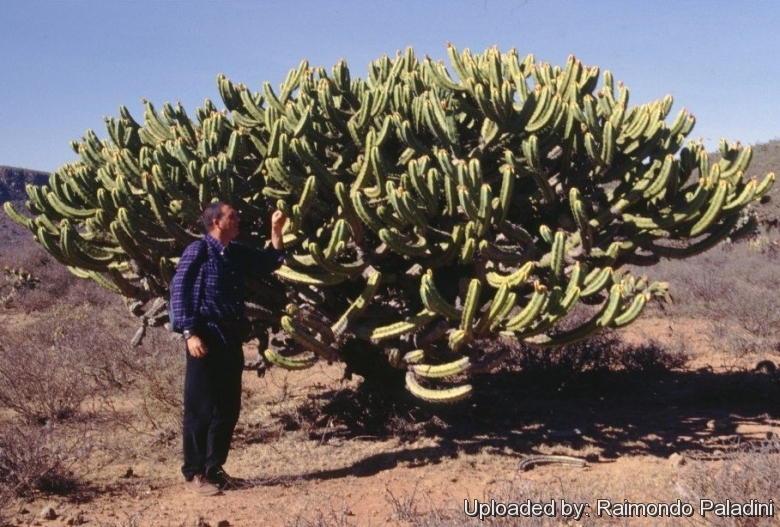
Myrtillocactus geometrizans Photo by: Raimondo Paladini
Mexico 12 December 1997. Myrtillocactus geometrizans is a blue grey candelabra like cactus of western Mexico bearing a small sweet, edible berrylike fruit.
Origin and Habitat: This species is endemic to Mexico, where it is widespread in the central states. It occurs in Aguascalientes, México Federal District, Durango, Guanajuato, Hidalgo, Jalisco, México State, Michoacán, Nuevo León, Oaxaca, Puebla, Querétaro, San Luis Potosí, Tamaulipas, Veracruz, Morelos and Zacatecas. It is known from at least 267 localities and has an area of occupancy of 51,000 km2
Altitude: It grows at elevations of 1,000 to 2,000 metres above sea level.
Habitat and Ecology: The species occurs in tropical deciduous forest, xerophyllous scrub and less frequently in grassland in some areas of the Chihuahuan desert. This species is widespread and locally common. Some habitats are disturbed by goats. The species has many different uses in the Tehuacán-Cuicatlán Valley, however the impact of harvest is low.
Synonyms:
See all synonyms of Myrtillocactus geometrizans
back
Accepted name in llifle Database:Myrtillocactus geometrizans (Mart.) ConsoleBoll. Reale Orto Bot. Palermo 1897, 10.Synonymy: 12
Cultivars
(1):
back
Common Names include:
ENGLISH: Our Father, Blue Flame, Bilberry Cactus, Whortleberry Cactus, Blue Candle, Blue Myrtle cactus
GERMAN (Deutsch): Myrtillocactus
ITALIAN (Italiano): Mirtillocactus
LITHUANIAN (Lietuvių): Mėlenis, Mėlynūnis
RUSSIAN (Русский): Миртиллокактус, Миртиллокактус геометрический
SPANISH (Español): Padre nuestro, Garambullo
SWEDISH (Svenska): Blåbärskaktussläktet, Blåbärskaktus
Description: Myrtillocactus geometrizansSN|8050]]SN|8050]] is a highly branched columnar candelabra like tree cactus that creates a dense growth of stems growing closely together. In nature grows up to 4.5 m tall, with the crown reaching up to 5 m in width.
Stems: Glaucous (blue grey) up to 7-10 cm thick. They have 5-8 ribs that are approximately 2.5 cm in depth with areoles about 2.5 cm apart.
Spines: Each areole may have up to 5-9 spines, but generally they have 3-5 spines about 5-12 mm long. Some spines but not awful.
Flowers: Rather smaller (2.5-3.7 cm) in relation to stem, greenish white.
Blooming season: It flowers between February and April and the flowers last for one day only. It starts blooming when it is about 60 cm tall.
Fruit: Very sweet, edible, dark red, oblong fruits 8-20 mm in diameter.
Remarks: Myrtillocactus geometrizansSN|8050]]SN|8050]] is commonly used as understocks for grafting cacti, (which is considered good and which is considered bad for certain). It's very easy to grow and is an excellent stock for small globular cacti that tend to rot off on their own roots and for slower growth seedlings such as Ariocarpus and Turbinicarpus that do not graft very well onto Trichocereus spachianusSN|8650]]SN|8650]] unless they are larger size pups. For these seedlings (and almost all other seedlings which are not cold hardy), the grafting stock Myrtillocactus geometrizansSN|8050]]SN|8050]] is a generally a better choice in warm climate.
Subspecies, varieties, forms and cultivars of plants belonging to the Myrtillocactus geometrizans group
Bibliography: Major references and further lectures
1) Edward Anderson “The Cactus family” Timber Press, Incorporated, 2001
2) James Cullen, Sabina G. Knees, H. Suzanne Cubey "The European Garden Flora Flowering Plants: A Manual for the Identification of Plants Cultivated in Europe, Both Out-of-Doors and Under Glass" Cambridge University Press, 11/Aug/2011
3) David R Hunt; Nigel P Taylor; Graham Charles; International Cactaceae Systematics Group. "The New Cactus Lexicon" dh books, 2006
4) Urs Eggli, Leonard E. Newton: “Etymological Dictionary of Succulent Plant Names” Springer, Berlin/Heidelberg 2010
5) Christopher Brickell “RHS Encyclopedia of Plants and Flowers” Dorling Kindersley Ltd, 01/Sep/2010
6) Willy Cullmann, Erich Götz (Dozent Dr.), Gerhard Gröner “The encyclopedia of cacti” Timber Press, 1987
7) Gerhard Gröner, Erich Götz “Beautiful Cacti: A Basic Grower's Guide” Sterling, 1992
8) Hecht “BLV Handbuch der Kakteen” BLV-Verlagsgesellschaft, 1982
9) E Haustein “Der Kosmos Kakteenfuehrer (the Kosmos Cactus Guide)” Balogh Scientific Books, United States, 01/Dec/1998
10) Sánchez , E., Guadalupe Martínez, J., Hernández, H.M., Gómez-Hinostrosa, C. & Cházaro, M. 2013. Myrtillocactus geometrizans. In: IUCN 2013. "IUCN Red List of Threatened Species." Version 2013.2. <www.iucnredlist.org>. Downloaded on 28 April 2014.
11) Jules Janick, Robert E. Paull "The Encyclopedia of Fruit & Nuts" CABI, 2008
12) Clive Innes "Complete Handbook of Cacti and Succulents" Van Nostrand Reinhold Company, 01/dic/1981
 Photo and © Copyright by Massimo Giannelli (Italy) Photo by: Cactus Art
Photo and © Copyright by Massimo Giannelli (Italy) Photo by: Cactus Art Myrtillocactus geometrizans Photo by: Valentino Vallicelli
Myrtillocactus geometrizans Photo by: Valentino Vallicelli Myrtillocactus geometrizans Photo by: Cactus Art
Myrtillocactus geometrizans Photo by: Cactus Art Myrtillocactus geometrizans Photo by: Valentino Vallicelli
Myrtillocactus geometrizans Photo by: Valentino VallicelliCultivation and Propagation: They are semi hardy, make sure that your Myrtillocactus are not exposed to temperatures below -4°C or they may die, nevertheless it is a good advice never let the nighttimes temperatures fall below 10°C. Water regularly in summer but allow to dry fully before watering again. Need a well-drained soil mix with small gravel added to ensure drainage.. During the winter months they should be rather kept dry and water is restricted to only enough to keep the stems and branches from shrivelling. Since they are big sized plants need plenty of space for their roots, repotting should be done every other year or when the plant has outgrown its pot. Exposure: Light shade when young, full sun later.
Propagation: Seeds, cuttings in summer (Cuttings will root only in hot weather. Cuttings must be kept very dry to root)














